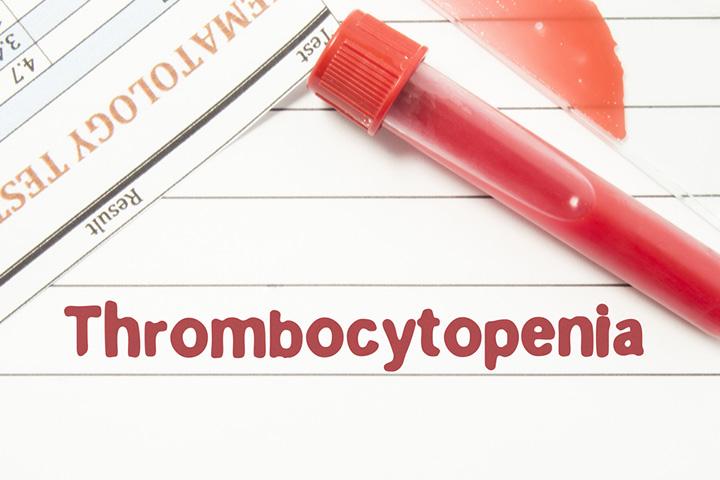Thrombocytopenia is a condition where a person has an abnormally low number of platelets (thrombocytes) in the blood. It is a common hematological issue seen in infancy. Platelets are vital for blood clotting and are produced in the bone marrow. Babies with thrombocytopenia could develop bleeding problems.
The normal platelet count in newborns and infants ranges between 150,000 and 450,000 per microliter. A platelet count of less than 150,000 per microliter indicates thrombocytopenia. Some babies, especially preemies, may have low platelet count in the first few days of life. However, it increases eventually.
Read this post to learn more about the causes, risk factors, signs, treatment, and complications of thrombocytopenia in babies.
Classification Of Thrombocytopenia
Neonatal thrombocytopenia can be classified based on the underlying cause, condition, or other factors leading to it. The following are some of the common types of thrombocytopenia (1).
- Immune thrombocytopenia (ITP)
- Thrombocytopenia due to infections, such as bacterial,viral, or fungal infections
- Drug-induced thrombocytopenia (DITP)
- Genetic and congenital anomalies-related thrombocytopenia
- Thrombocytopenia due to increased consumption of thrombocytes, a result of conditions such as hypersplenism and necrotizing enterocolitis
- Thrombocytopenia due to miscellaneous causes
- Idiopathic thrombocytopenia where there is no known cause
Causes Of Thrombocytopenia In The Newborn
Inadequate production and early breakdown of platelets are the primary causes of thrombocytopenia in babies. The following conditions during fetal life or after birth can cause platelet dysfunctions in infants (2).
- Preeclampsia (high maternal blood pressure)
- Genetic disorders
- Metabolic disorders
- Exposure to certain drugs, such as aspirin and indomethacin, during fetal life or after birth
- Bone marrow infections in the fetal stage
- Infections, such as rubella and syphilis
- Maternal antibodies against fetal platelets causing an early breakdown of the newborn’s platelets
- Perinatal asphyxia (oxygen deprivation during birth)
- Intrauterine growth restrictions
Illnesses in babies may trigger the early breakdown of platelets. In some babies, the cause of low platelet counts is not known, and it is called idiopathic thrombocytopenia.
Risk Factors For Thrombocytopenia In Babies
The following factors may increase the risk for thrombocytopenia in babies (1).
Thrombocytopenia in ill babies, premature babies, and babies admitted in NICU may indicate underlying pathological processes. Platelet count in the fetus increases with gestational age. Since premature babies are born early, they are likely to have lower platelet counts for a few weeks.
Signs And Symptoms Of Thrombocytopenia
The common signs and symptoms of thrombocytopenia in newborns include the following (2).
- Petechiae, small red spots on the skin
- Bruises on skin
- Purpura or skin hemorrhages that also appear as red spots
- Bleeding from various parts of the body, including nose bleeding, gum bleeding, and intestinal bleeding
- Jaundice may occur due to bruising, and the baby develops yellow skin and eye color
- Intracranial hemorrhage
Clinical features may vary depending on the severity of thrombocytopenia. Some babies could be born with these symptoms, while a few may develop them within days after birth. You may seek medical care for an exact diagnosis since these signs and symptoms are also seen in other conditions.
Diagnosis Of Thrombocytopenia
Physical examination and the symptoms can be suggestive of thrombocytopenia. Blood tests are ordered to determine the platelet counts (3). Thrombocytopenia is often detected during routine blood examination in asymptomatic babies.
Additional tests, such as kidney function, liver function, erythrocyte sedimentation (ESR) rate, vitamin B12 and folic acid levels, and bone marrow aspiration, could be conducted to diagnose thrombocytopenia or exclude the possibility of other illnesses. Imaging tests are often required to look for intracranial hemorrhages.
Treatment For Thrombocytopenia In Babies
The treatment options may vary depending on the underlying cause. Babies with mild thrombocytopenia and who show no clinical signs and symptoms require no treatment. Platelet transfusion is necessary for babies with too few platelet counts and clinical manifestations (4).
Babies with maternal antibodies against platelets receive low doses of steroids. It may take four to eight weeks to completely clear maternal antibodies from the infant’s blood.
If there is a known risk of thrombocytopenia before birth, the baby could require transfusion of maternal platelets after birth. If maternal platelets are not available, the donor platelets are used. The donor platelets are transfused with intravenous immunoglobulins to reduce immune-mediated destruction.
The type of delivery is also planned according to the platelet count in the fetal blood. Vaginal delivery is attempted only if the fetal platelet count is more than 50,000 per microliter. Cesarean section is recommended if the platelet count is lower than it.
Possible Complications Of Thrombocytopenia In Newborns
Thrombocytopenia complications are due to bleeding, which occurs due to low platelet count. Bleeding into tissues and skin is common. Bleeding could also increase the breakdown of erythrocytes (red blood cells), leading to excess bilirubin, aby product. It could eventually result in jaundice (5).
Intracranial hemorrhages (bleeding within the skull) can be life-threatening since it increases intracranial pressure and causes oxygen deprivation to tissues. If not resolved on time, severe bleeding could result in cardiovascular dysfunction, shock, and prolonged inadequate oxygen supply to the brain, leading to permanent brain damage.
Thrombocytopenia or low platelet count could improve in many babies without any treatment. However, early identification and management of low platelet count could improve the outcome. Always seek medical care if you notice bleeding or skin rashes in newborn babies.

